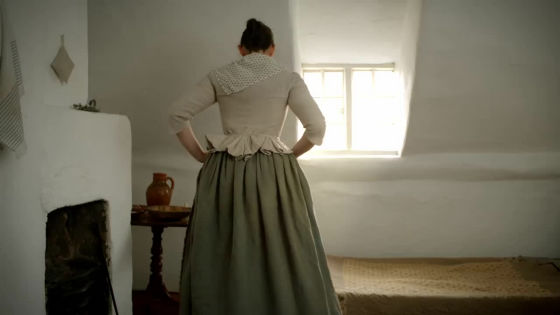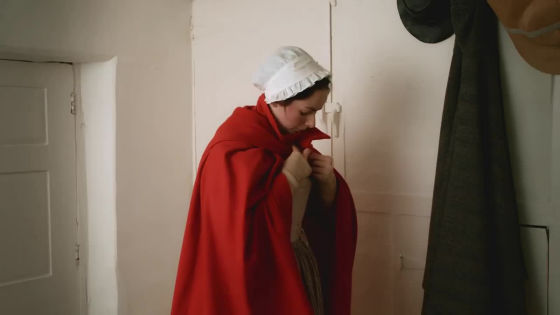All processes of "How did women in the 18th century wear garments" are being released in the movies

Concept was made to produce historically correct imagesCrow's Eye ProductionsHowever, an explanation image of "How did a woman working in the 18th century wear clothes" is being released on YouTube. Costumes are clothing historians, have been making costumes for 30 years, and have been made by Pauline Loven that 10 years have been making costumes for movies as well.
Getting dressed in the 18th century - working woman - YouTube
A woman waking up with a roaring cry.

Wearing on your skin isShift dressA gentle dress not to narrow down the waist. Also called chemise, it is made of linen. The shift dress was also used as nightclothes. Cleanliness is sought, so it seems that women usually wear wearing clothes changing while washing two or more shift dresses.

Pour water into the dish ......

Washing face.

Next, I will wear knitted socks. Socks sometimes have been subjected to embroidery to hide the seams.

Socks are to the knee top.

Under the kneegarterSomething like a ribbon is tied up.

Shoes are low in heels, practical.

Subsequently taken out is a compensating underwear called Stays. So-calledcorsetIt is. Stays of this era were worn for the purpose of stabilizing the bust rather than to tighten the waist. Also, because it is exposed to the outside, design was also important for working women.

Roll up and undo the stays fixed with a string ... ...

First let's pass the arm.

Turn it behind ......

I will wear it like a vest.

Since a long string is attached, I will pass a string through the hole so that it knits up from the bottom.

At that time Stays was required to be easy to move and easy to remove, so it was in a form that could be knitted up front and back. Stages of this era are "A Pair of BodiesAlso known as a breastplate called "stomacher" is inserted in the knitted part of the front side ... ....

The seams were hidden like this. Because women needed to take off clothes that are coming up due to hard labor and heat, stomacher was also an item that makes us look elegant even if I take off my clothes.

Next was my pocket.

The pocket is fixed by winding the string around the waist.

In your pocketPetty CourtIt is said that it can access from the side of.

So I will wear a petticoat.

Petti cord is made from a rectangular cloth, first fixed with a string extending from the back side Petit Code on the waist.

Subsequently, a string extending from the Petty Court on the front side is wrapped around the waist and it is enclosed on the back side ......

I will also tie it on the front side. Thanks to this making it is possible to access the pocket from the side. Also, because it does not care about your body shape, pregnant women can wear the same Petty Code as usual.

Petty code to wear on the outermost side was used frequently, it was made of bright wool and linen / cotton cloth with a handle. Quilts are also used during winter.

This is also made from two parts as before, and it is fixed with a string to the waist.

The hair is shed behind and it is gathered together.

In addition, the neck chief was used for hiding the neck which appears by raising the hair, for warming up and sun shading.

The tip of the neck chief is put in the stays.

She wears a jacket and short gown on the Stays · Petty Court ......

The front side of the jacket is pinned. The pin seems to be firmly fixed to the stage.

The sleeves of the jacket were up to the bottom of the elbow, and it was designed not to disturb the work.

An apron keeps clothes clean, wipes his hands, it is an important substitute for mittens.

Looking from behind, it is like this.

When going out to the public place, white linen caps were worn.

A ribbon is tied on the head and it is fixed.

A woman is ready and goes out of the room.

The hem of Petty Court is above the ankle. This makes the feet easy to see so that women can climb up and down the stairs while holding objects with both hands.

Since the jacket is under the elbow, we wore long gloves without fingers in the cold winter season.

And when he goes out he seems to have worn something like a long hood with a hood or a coat for horse riding. Especially from the mid 18th century to the nineteenth century, the red wool exterior was popular in the British countryside. Fairy taleLittle Red Riding Hood"A red skeleton is drawn symbolically.

Related Posts:
in Video, Posted by darkhorse_log







